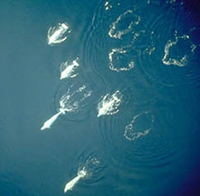NOAA Builds Framework for Future Beluga Hunts in Cook Inlet
June 20, 2008
NOAA’s Fisheries Service today released a final environmental impact statement for the management of Alaska native subsistence hunting for beluga whales in Cook Inlet.

Beluga whale.
High resolution (Credit: NOAA)
Federal law provides for traditional subsistence harvests for the native Alaska population. However, the federal government may regulate these harvests when a species or stock, such as the Cook Inlet beluga, is depleted.
“This document provides a long-term framework for subsistence harvest when the population recovers sufficiently,” said Doug Mecum, acting administrator for NOAA’s Fisheries Service Alaska region. “We need a plan that recognizes the nutritional and cultural needs of Alaska natives, but gives priority to Cook Inlet beluga recovery.”
The preferred alternative in the Cook Inlet beluga whale subsistence harvest final supplemental environmental impact statement would set annual harvest quotas based on the abundance and growth of the population. Harvests would be authorized only when the five year average abundance is above 350 whales. The current five year population average, from 2003 to 2007, is 336 belugas.
The document also requires reduced harvest levels to compensate for unusual events, such as a mass stranding of belugas.
A record of decision on the document is expected at the end of July.

Beluga whale pod.
High resolution (Credit: NOAA)
No Cook Inlet beluga whales were harvested in 2006 or 2007, and no harvest is planned this year. Currently, there is no co-management agreement in place for the next five year interval, from 2008 to 2012, although NOAA’s Fisheries Service will continue to coordinate on Cook Inlet beluga issues with the local hunters and villages.
NOAA Fisheries scientists and managers have studied the Cook Inlet belugas since 1993, with efforts including annual population surveys and abundance estimates, co-management agreements, two comprehensive status reviews, research, tissue collections, a conservation plan, and responses to stranded beluga whales. According to these studies the Cook Inlet beluga whale population decline averaged 2.7 percent annually between 1999 and 2007.
The Cook Inlet beluga population is one of five beluga stocks recognized within U.S. waters, for a total population estimate of 63,000 beluga whales in all U.S. waters.
The Cook Inlet beluga population is listed as depleted under the Marine Mammal Protection Act. In 2007, NOAA’s Fisheries Service proposed the Cook Inlet beluga population be listed as endangered under the Endangered Species Act. The agency is scheduled to make a determination on the listing in October.
NOAA is dedicated to enhancing economic security and national safety through the prediction and research of weather and climate-related events and information service delivery for transportation, and by providing environmental stewardship of our nation's coastal and marine resources. Through the emerging Global Earth Observation System of Systems (GEOSS), NOAA is working with its federal partners, more than 70 countries and the European Commission to develop a global monitoring network that is as integrated as the planet it observes, predicts, and protects.
